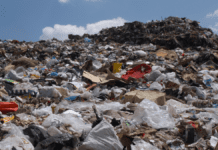
Envirotec struggles to find solid takeaways in the literature about PFAS contamination in landfills, and what might be done about it. As regulations tighten, the topic seems to be growing more urgent.
A contaminant whose importance appears to have grown significantly in recent years, poly- and perfluoroalkyl substances (PFAS) present a challenge to pollution management given their apparent toxicity – although a clear picture is still emerging – and persistence. The tag “forever chemicals” is clearly very appropriate for a class of synthetic compounds whose unusual molecular structure, including the carbon-fluorine (C-F) bond (considered one of the strongest found in organic chemistry), appears to offer little scope for any thermal or other degradation at all, so they endure permanently.
They make ideal surfactants, given their water- and oil-resistance, although this also contributes to their extreme mobility – problematic for those who might seek to constrain them.
These and other properties have made them an all-but-indispensable ingredient in a wide range of consumer and industrial products, and they have been used since the 1940s with applications including textiles and clothing, electroplating, fire-fighting foam, and ammunition.
And there are many of them (more than 4,000 on the global market). Most of the health studies and legislation have focused on the “long chain” PFAS compounds – whose molecular structure tends to feature 7 or more carbon atoms – and includes things like perfluorooctane sulfonic acid (PFOS) and perfluorooctanoic acid (PFOA).
These compounds are known to accrete in human tissues, through consumption of contaminated food or water, and are not readily excreted. Efforts to phase out PFOS began in the US and Europe in the early 2000s, and these long-chain PFAS have gradually been substituted with short-chain replacement compounds, offering some of the same properties but presumed less toxic – an appraisal that seems to have been premature as these compounds are believed to raise similar health concerns.
The short-chain PFAS tend to feature 4 to 6 carbon atoms in their molecular structure, and include materials like perfluorobutanoic acid (PFBA) and GenX.
With their wide deployment and persistence, it’s no surprise PFAS collect in landfills – one of a number of acute pressure points in the environment where there is an elevated risk of their finding their way into soil, water and air. Numerous studies attest to their presence in landfills large and small, young and old, across diverse geographies and using different modes of operation. And they seem to appear in diverse landfill media, including solid waste, leachate, and the air at these sites.
Reliance on landfill is diminishing but it has served as the destination for more than 50% of the municipal solid wastes in the US, for example.1
A January 2023 paper, appearing in the journal Waste Management, attempted to draw conclusions from the studies completed to date, looking at things like the occurrence and transformation of PFAS at these sites, factors affecting PFAS compounds’ release from waste, its effect on the liner system, and potential treatment technologies.2
Immediate weaknesses are apparent in the extant literature, however, and the authors, Zhang et al note that “the majority of current studies have targeted only a small fraction of PFAS (<200 out of > 4000 on the global market), which can lead to serious underestimation.”
Based on what’s been researched, a few nuggets of insight appear forthcoming about the types of PFAS prevalent at these sites. Shorter chain C4-C7 PFCAs, for example, appear the most abundant in landfill leachate in the US, Europe and Asia. Longer-chain PFAS such as PFOS and PFOS-precursors seem to dominate in landfill sediment.
With leachate, the short-chain predominance might be attributed to things like their higher solubility in water, the shift in global production towards these compounds in recent decades, and potential transformation mechanisms at landfill sites (where long chain compounds degrade into shorter chain ones).
“Mercurial” might be the term best applied to substances whose manifestations appear numerous and whose behaviour eludes easy categorisation.
Maybe the recent studies are the most trustworthy, as researchers get a better idea of what’s happening. A 2021 study by Liu et al, for example, seems to find PFAA precursors make up most of the “fresh liquid from waste collection vehicles”, while the leachate from the landfill where the same waste was left seems to be dominated by PFAAs, suggesting that a transformation is occurring at the landfill site.3
There has been lots of work attempting to correlate PFAS occurrence at landfills with factors like the type of waste, the age of the landfill, how it is operated and so on. No clear correlation with waste types seems apparent at this stage, but then only a small number of the most dominant PFAS have been studied. One study notes a higher prevalence of PFHxS in C&D leachate, likely due to its use in sealants and other building materials.
PFAS concentrations seem lower in older landfill sites, although this effect diminishes with those which closed more recently than 1993, and the growing prevalence of short-chain replacements like PFNA and PFBS over time reflects their greater usage as legislation changed. But PFAS might be expected to deplete over time in landfills because of things like desorption, leaching and decomposition.
Biological processes such as methanogenesis seem to encourage PFAS to release into leachate, and studies of bioreactor-style landfills seem to show more PFAS here than dry-tomb landfills.
These materials appear to be subject to a dizzying range of effects and dependencies over time, as landfill material passes through different phases of decomposition for example, and these in turn affect chemical properties like pH, which in turn affects things like adsorption and desorption. Zhang et al conclude that the release of PFAS from waste could be influenced by things like pH, dissolved organic matter (DOM) and electrical conductivity.
Do PFAS leak through landfill liners and geomembranes? Zhang et al conclude that “there is very limited data published to date” on the matter. One study of PFOA and PFOS onto a plastic geomembrane (LLDPE) seems to show that these PFAS have partitioning coefficients “at least two orders of magnitude lower than” other common hydrophobic (water repellent) compounds found in leachate (like benzene and PCBs). In other words, showing a greater propensity to leak. However, after 202 days of testing at different temperatures, the concentrations of these two PFAS remained below the detection limits in the receptor cells. So, no obvious leakage then.
Existing removal methods
When it comes to removing PFAS from leachate, there is a lot of data appraising activated carbon adsorption, ion exchange, biological treatment, and membrane separation.
Activated carbon has been more effective with longer-chain than short-chain compounds – a finding also apparent with groundwater, say Zhang et al. Its effectiveness depends on the adsorption rate of PFAS, which will be lower when it has to compete with other solutes in the leachate.
However, it doesn’t destroy PFAS, and disposing of the PFAS-laden media is costly as it involves expensive solvents like methanol (and subsequent disposal and handling) – and so very often this spent media is sent for incineration, which again is costly given the high temperature (over 900ºC) required to destroy PFAS.
Ion exchange removes PFAS, but like AC it doesn’t destroy them, presenting a need for costly regeneration or disposal of media.
Membrane separation methods like ultrafiltration and reverse osmosis (RO) have also been used to treat landfill leachate for many years, although ultrafiltration is ineffective. RO is “one of the most promising technologies” that has been used for leachate treatment but is energy-intensive, subject to membrane fouling if other materials or suspended solids are present, and – again – it doesn’t destroy PFAS so the RO concentrate has to be dealt with using methods that are all quite costly.
Emerging techniques to treat PFAS from leachate include foam fractionation, whereby gas bubbles are introduced, which are able to concentrate PFAS at the gas-liquid interface of the bubbles. Like RO, this concentrates PFAS in a form ready for removal and destruction.
In discussion of PFAS treatment and clean-up generally, Ian Ross – co-author of The Contaminant Handbook – has suggested solutions are likely to comprise “multiple technologies working in tandem”, and seems to anticipate a two-step process, where one of the aforementioned methods is used to remove PFAS from liquid media or water, and then this concentrated form is worked on by a destructive technology.4
Destructive methods
Hopes for a biological approach to remediate media such as soil and water have been suggested as “unlikely” by Ian Ross in a 2021 article.5 The somewhat alien chemistry of PFAS seems an obstacle, and he describes it as “a true xenobiotic” whose arrival on Earth, as it were, is a recent event.
Emerging chemical and physical possibilities for removal and destruction of PFAS in leachate include electrochemical oxidation, photocatalytic oxidation, and plasma-based treatment.
With electrochemical oxidation, Zhang et al cite a 2021 study demonstrating an average removal efficiency of 80% and 78% for PFOA and PFOS at a current density of 75 mA/cm2 after eight hours. And this could be increased to 100% with a higher current density, but with the formation of shorter chain PFAS. The method can also produce toxic halogens like perchlorate, presenting additional treatment demands. It seems expensive at present, with this study using boron-doped diamond (BDD) electrodes. There is also a high potential for electrode fouling when using real waste streams, suggest Zhang et al.
Photocatalytic oxidation, on the other hand, has successfully removed large proportions of PFAS from leachate relatively quickly (> 95% of 13 PFAS within 2 hours) in a 2021 study. It employs a novel electrode system (Fe-doped carbon-supported titanate nanotubes) to bind the PFAS prior to its destruction using UV light. However, this seems to lead to the creation of PFBA and PFPeA.
Plasma-based treatment also offers a way to destroy PFAS in leachate (or water). A 2021 study demonstrates a very high degree of PFAS removal after only 10 minutes (90% of PFOA and PFOS, >99.9 % of long-chain PFAAs, and 10–99.9 % of short-chain PFAAs). Problems so far include the generation of toxic halogen chemicals like chlorite, and challenges with scaling up – for example, making the plasma technology practical with a high flow rate of material.
Certainly, the need for reliable methods of treatment grows increasingly urgent. March 2023 saw a notable legislative landmark with the US EPA announcing the first enforceable drinking water limits for six PFAS with adverse health effects: PFOA, PFOS, and mixtures containing the shorter-chain compounds PFBS, PFHxS, PFNA, and GenX. Compliance will require monitoring down to miniscule levels, including 4ng/L for both PFOA and PFOS. As Ian Ross points out on the website of US firm CDM Smith, “Some studies have shown that rainfall in parts of the US has exceeded these levels.”
References
[1] “Poly- and Perfluoroalkyl Substances (PFAS) in Landfills: Occurrence,
Transformation and Treatment”, Zhang et al, Waste Management 155 (2023) 162-178.
[2] ibid
[3] ibid
[4] “An enduring threat to water”, Envirotec magazine, May 2021






